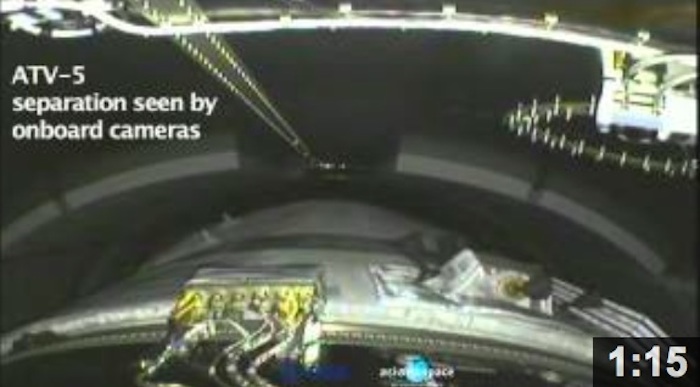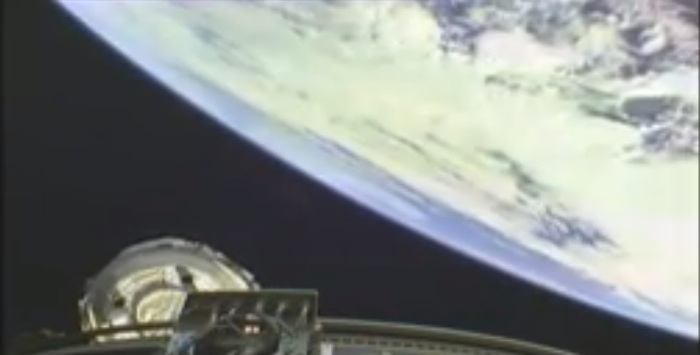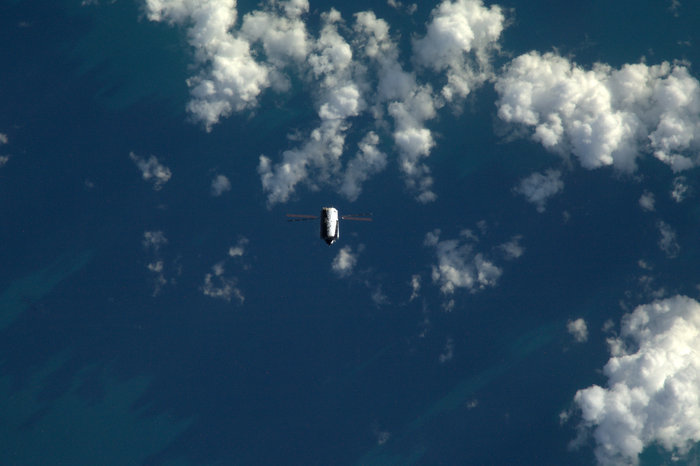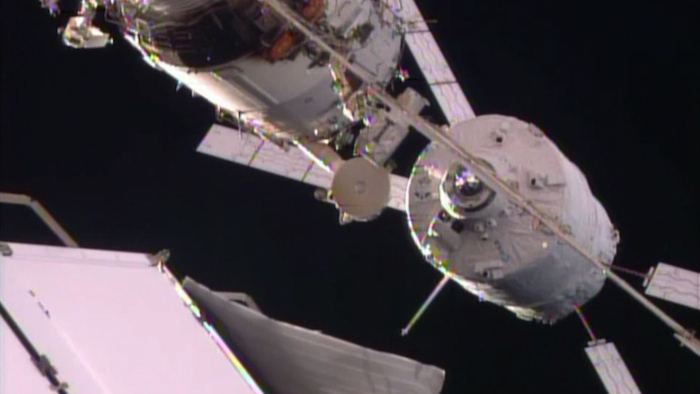.
30.07.2014

Europe’s ATV-5 cargo ship has set sail on a 14 day journey to the International Space Station (ISS) on Tuesday. The final ATV mission began when the vehicle’s Ariane 5 ES carrier rocket launched the “Georges Lemaître” from the Guiana Space Centre, in Kourou, French Guiana at 23:47 UTC.
ATV-5:
Arianespace’s latest ATV mission in support of International Space Station operations was designated as Flight VA219 in the company’s numbering system, and utilized an Ariane 5 ES version of the heavy-lift workhorse.

ATV-5 is scheduled for a 14-day flight to the station, with docking to the aft port of the Russian Zvezda service module at 13:34 UTC on Tuesday, August 12.
.

(ATV-3 Docking Animation created from 70 hi res ATV-3 docking images acquired by L2 – LINK).
During its trip to the space station, the vehicle will fly four miles below the space station on Friday to test sensors for potential use on future European spacecraft before beginning the final phase of its rendezvous with the orbital laboratory.
Although this will be the last scheduled ATV flight, its legacy will continue in the realm of Beyond Earth Orbit (BEO), via hardware contributions as the Service Module (SM) for NASA’s Orion spacecraft.
Quelle: NS
.
Update: 4.08.2014
.
The ATV-5 was released into a circular ORBITby the Ariane 5 ES launch vehicle, at an inclination of 51.6 degrees and an altitude of 260 km.
After separating from the launch vehicle, the ATV-5 will be autonomous, using its own systems for energy (batteries and four large SOLAR PANELS) and guidance (GPS, star sensor), in liaison with the CNES control center in Toulouse. During final approach, an optical navigation system will guide the ATV-5 to its rendezvous with the Space Station, where it will automatically dock on August 12. It will remain docked to the ISS for nearly six months, before making a guided reentry and disintegrating in the atmosphere.
The ATV ferries supplies to the International Space Station (ISS), including water, oxygen, fuel, spare parts and equipment for onboard experiments, on behalf of ESA and NASA. Docked to the ISS, the ATV also helps reboost the ISS into its NOMINAL orbit at an altitude of 450 km. The ISS structure now weighs about 420 metric tons, and includes the European laboratory, Columbus. After being docked to the ISS for six months, the ATV-5 will be loaded with waste and other expendable materials, then detached from the ISS and deorbited.
.





Quelle: arianespace
.
Beobachtungs-Hinweis: Heute Abend (4.08.2014) um 23.15 MESZ Überflug von ISS und ATV-5 von SW (bei klarer Sicht)
.
Update: 10.08.2014
.

.

Quelle. ESA
.
Update; 12.08.2014
.
Andocken von ATV5 an ISS
.

ATV-5 seen passing under the ISS on 8 August during the LIRIS docking technology test. This image was taken by astronauts on board the ISS around the time ATV-5 made closest approach at 21:07:04 GMT.
.
ESA’s latest Automated Transfer Vehicle is set to dock with the International Space Station on Tuesday, delivering more than six tonnes of crucial supplies and scientific experiments to the orbiting research base.
ATV Georges Lemaître will rendezvous with the Station at about 410 km altitude at 09:21 GMT (11:21 CEST) and complete a fully automated docking with the aft port of Russia’s Zvezda module at 13:30 GMT (15:30 CEST).
The vessel was given a ‘GO’ for docking by the Station’s mission MANAGEMENT TEAM earlier today, and ESA’s ATV Control Centre in Toulouse, France, are now preparing the final commands.
“Since launch on 29 July, ATV has conducted a SERIES of manoeuvres to bring it up to the Station altitude, and these have gone flawlessly,” says Jean-Michel Bois, leading the ESA operations team at the control centre.
“The vessel is functioning perfectly and we are looking forward to a smooth – and final – ATV docking.”
.

ESA astronaut Alexander Gerst and Russian cosmonaut Alexander Skvortsov participate in the last ever onboard training for the docking of the Automated Transfer Vehicle (ATV).
Launched from Europe's Spaceport in French Guiana on 30 July, ATV-5 is set to automatically dock with the International Space Station on 12 August under the guidance of the two Alexanders.
ATV-5 is the fifth and final ATV spacecraft and delivers over seven tonnes of cargo to the ISS.
.Status is GO
In addition to the dozen manoeuvres needed to get up to the final altitude and then align ATV’s orbit with that of the Station’s, CONTROLLERShave spent the past two weeks checking out the health of the onboard systems, including the Russian-designed docking system and the automated laser guidance.
Docking will be monitored closely by ESA astronaut Alexander Gerst and cosmonaut Sasha Skvortsov, who have been refreshing their training while on the orbital outpost.
The crew can command an abort if they observe anything going wrong during the docking process.
Flying under ISS
On 8 August, ATV-5 performed a ‘flyunder’ of the Station, passing 8 km below to gather video FOOTAGE with special cameras installed on its front cone.
The FOOTAGE is part of the experimental LIRIS demonstrator – short for Laser InfraRed Imaging Sensors – a new rendezvous guidance system.
The new technology is the first step towards a FUTURE system that would allow rendezvous with an uncooperative target in space.
On future missions, INFRARED CAMERAS and the lidar sensors – the light equivalent of radar – would scan the targets while onboard computers process the data using new guidance navigation and control software.
LIRIS will be turned on for tomorrow’s docking, but will only record data for later analysis. The actual automated docking will be CONTROLLED by ATV’s tried-and-proven docking system that uses GPS and laser signals reflected from Zvezda.
Record-setting mission
Once docked, ATV-5 will remain attached for up to six months before leaving with waste material for destruction along with the spaceship during atmospheric reentry.
The last ATV will deliver a record amount of around 2680 kg of dry cargo in its manifest totalling 6602 kg. In addition, and for the first time, the space freighter’s three WATER TANKS are fully loaded, totalling 850 litres.
It is also carrying a new pump to recycle urine into drinkable water, a reentry camera to record ATV’s eventual controlled destruction after undocking, and Europe’s electromagnetic levitator for materials science INVESTIGATIONS.
At a total launch mass of 20 245 kg, ATV-5 is the heaviest spacecraft ever launched by Ariane 5.
Quelle: ESA
.
Update: 17.25 MESZ
.

The European Space Agency’s fifth and final Automated Transfer Vehicle (ATV-5) cargo ship has completed its two week trek to the International Space Station. Named after the 20th century Belgian astronomer, the “Georges Lemaître” docked automatically to the Zvezda service module’s aft port Aug. 12 at 9:30 a.m. EDT.
The ATV-5 launched atop an Ariane 5 heavy-lift rocket July 29 from Kourou, French Guiana, carrying nearly seven tons of science, supplies, food and fuel to replenish the station crew.
During its slow, deliberate approach to the space station, the ATV-5 flew less than four miles underneath the station on Friday, Aug. 8 to test new rendezvous sensors and laser systems before looping above and behind the station for the final phase of its rendezvous. The advanced technology was tested for possible incorporation in the design of future European spacecraft.
ESA’s first ATV, the “Jules Verne,” launched from Kourou in March 2008 during Expedition 16 for a month-long trek to Zvezda’s aft port. The next three European resupply craft, the “Johannes Kepler,” the “Edoardo Amaldi” and the “Albert Einstein”, all launched from the same site at the Guiana Space Centre, docked to Zvezda and completed their missions with a destructive reentry over the Pacific Ocean.
As the ATV-5 begins its six-month stay, another space freighter, the Cygnus commercial cargo craft from Orbital Sciences, is being prepared for its departure from the station’s Harmony module Friday at 6:40 a.m. EDT to complete a month-long delivery mission. Expedition 40 crew members Alexander Gerst of ESA and NASA’s Reid Wiseman will be inside the cupola to release Cygnus using the Canadarm2 robotic arm.
The “Georges Lemaître” is scheduled to end its stay at the station and complete its mission in January 2015. The ATV-5 will undock from Zvezda at the beginning of the year loaded with trash and discarded gear for a fiery disposal over the Pacific Ocean.
.

Quelle: NASA
.
Update: 14.08.2014
.

ESA's ATV-5 cargo vessel seen in orbit by cameras on the ISS prior to docking on 12 August 2014.
.
In a flawless demonstration of technology and skill, ESA’s fifth and final ATV, Georges Lemaître, docked with the International Space Station today, fixing itself firmly for a six-month resupply and reboost mission.
The fully automated docking came at 13:30 GMT (15:30 CEST), just a few moments after the CARGO vessel’s extended probe made contact with the cone on the aft of Russia’s Zvezda module.
After contact, a series of hooks latched and closed, making a firm mechanical connection with the Station. Later, data and electrical connections were created, allowing ATV to draw power from the ORBITAL outpost and for the Station computers to talk directly to ATV.
The sequence came at the end of several hours of automated manoeuvres, during which ATV powered itself through a series of waypoints starting some 40 km behind and just below the Station.
ATV navigates itself
“From 39 km to just 250 m from the Station, ATV navigated itself using relative satnav signals, in which both the Station and ATV compare their positions using GPS,” says Jean-Michel Bois, leading the ESA operations team at the ATV CONTROL Centre in Toulouse, France. Mission operations are run jointly with France’s CNES space agency.
“For the final 250 m, ATV navigated using a ‘videometer’ and ‘telegoniometer’, which use laser pulses to calculate the distance and orientation to the Station.”
The entire process was completed flawlessly, carefully monitored by the ground team and ESA astronaut Alexander Gerst and cosmonaut Sasha Skvortsov on the Station.
"European cargo spaceship Georges Lemaître has successfully docked to the ISS and the crew sends their congratulations to all the brilliant engineering teams on the ground and in ATV CONTROLCenter in Toulouse and in Moscow and to those who have contributed over the last 20 years to the development of one of the most advanced resupply vessels that circles our planet," said ESA astronaut Alexander Gerst on board the ISS.
"While this is the last of the ATV FLIGHTS, the know-how and technology will soon fly again as early as 2017 to power NASA’s Orion spacecraft with the European Service Module, paving the way for the next generation of space exploration."
The crew will open the hatch and enter briefly over the next day, installing a fan to freshen the internal air before ATV is made ready for daily use.
One of ATV’s most crucial capabilities – using its thrusters to reboost the Station’s altitude – will be tested in just two days, with a test burn scheduled for 14 August.
Teams perform magnificently
“The final arrival of Europe’s ATV space freighter was almost anticlimactic, as the vessel’s made-in-Europe docking technology performed perfectly for the fifth and final time,” said Massimo Cislaghi, ATV-5 mission manager.
“Most importantly, the crew in space and the ESA, CNES and industry teams on ground performed magnificently, and it is thanks to their dedication over the life of this project that ATVs have won a reputation for being some of the most reliable and dependable space vessels ever flown.”
Named after the Belgian scientist who formulated the Big Bang Theory, ATV Georges Lemaître lifted off at 23:47 GMT on 29 July (01:47 CEST 30 July) on an Ariane 5 rocket from Europe’s Spaceport in Kourou, French Guiana.
The vehicle is carrying 6602 kg of freight, including 2680 kg of dry CARGO and 3921 kg of water, propellants and gases.
The CARGO includes complex scientific hardware, such as the electromagnetic levitator for experiments to improve industrial casting processes. The unit will allow finer metal castings and more precise measurements than can be obtained on Earth, where readings are affected by gravity.
Quelle: ESA
4738 Views
